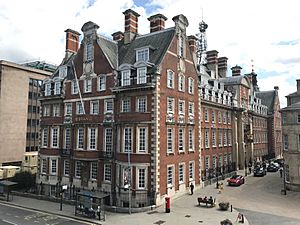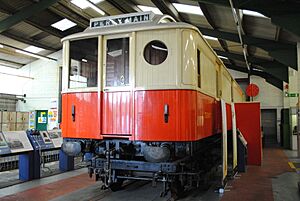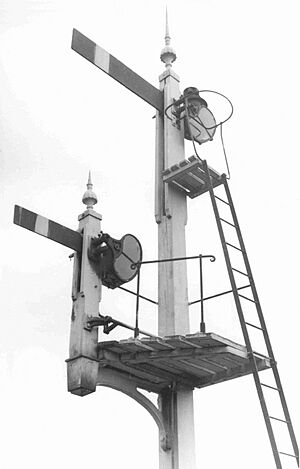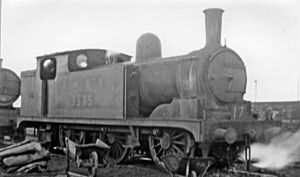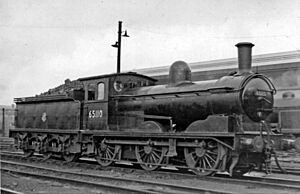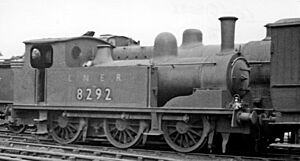North Eastern Railway (United Kingdom) facts for kids
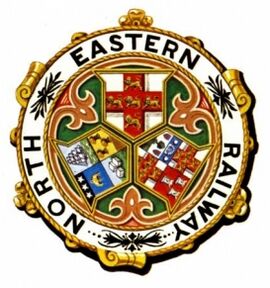 |
|
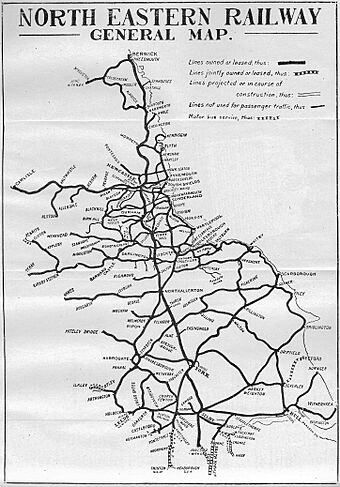
1920 map of the railway
|
|
| Overview | |
|---|---|
| Headquarters | York |
| Reporting mark | NE |
| Locale | North East, Yorkshire |
| Dates of operation | 1854–31 December 1922 |
| Predecessor |
|
| Successor | London and North Eastern Railway |
| Technical | |
| Track gauge | 4 ft 8 1⁄2 in (1,435 mm) standard gauge |
| Length | 1,754 miles 73 chains (2,824.3 km) (1919) |
| Track length | 4,990 miles 44 chains (8,031.5 km) (1919) |
| North Eastern Railway Act 1887 | |
|---|---|
| Act of Parliament | |
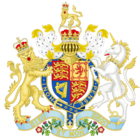
|
|
| Long title | An Act for enabling The North Eastern Railway Company to make new railways; and for other purposes. |
| Citation | 50 & 51 Vict. c. l |
| Dates | |
| Royal assent | 23 May 1887 |
| Text of statute as originally enacted | |
The North Eastern Railway (NER) was a big English railway company. It started in 1854 when several smaller railway companies joined together. Later, in 1923, it became part of a much larger railway called the London and North Eastern Railway (LNER). This happened during a time called the "Grouping," when many British railway companies merged.
Today, the NER's main line is still a very important part of the East Coast Main Line. This line connects major cities like London and Edinburgh.
The NER was special because it mostly operated in one area: Yorkshire, County Durham, and Northumberland. It had almost complete control over railways in this region. The NER's main line was the middle section of the "East Coast Main Line." It connected with the Great Northern Railway near Doncaster and the North British Railway at Berwick-upon-Tweed.
Even though it was an English company, the NER also had a small part of its line in Roxburghshire, Scotland. This made it the only English railway that fully owned a line in Scotland. The NER also ran trains regularly into Scotland.
The company owned about 4,990 miles of track. Its main offices were in York, and it had workshops in Darlington, Gateshead, and other places.
The NER was known for being innovative, meaning it liked to try new things. It was a leader in railway building design and in using electricity for trains. The company also started the collection that later became the National Railway Museum in York.
During the First World War, 2,236 men from the NER lost their lives. They are remembered at the North Eastern Railway War Memorial in York. The company even created two special army groups, called 'Pals Battalions,' made up of its own employees.
The NER's special symbol, or heraldic device, combined symbols from the three main companies that formed it in 1854. These were the York and North Midland Railway, the Leeds Northern Railway, and the York, Newcastle and Berwick Railway.
Contents
How the North Eastern Railway Grew
The North Eastern Railway was formed by many smaller railway companies joining together over the years. This helped it become a very large and powerful railway network in the north of England.
For example, when the NER started in 1854, it was created from the York, Newcastle and Berwick Railway, the York and North Midland Railway, the Leeds Northern Railway, and the Malton and Driffield Railway.
Later, other important companies joined, like the Stockton and Darlington Railway in 1863. This was a very famous railway because it was one of the first public railways in the world to use steam locomotives.
The NER also took over several dock companies, like the Hull Dock Company in 1893. This helped the railway transport goods to and from ships.
Important Stations
The NER built some of the most impressive railway stations in Britain. Many of these stations had huge, curved roofs, like the one at Newcastle Central.
- York station was the main center of the railway and where its headquarters were located. The current station opened in 1877.
- Newcastle station in Newcastle opened in 1850 and became the largest station on the NER.
- Leeds New Station (now Leeds) opened in 1869. It was a joint project with another railway company.
Some of these grand stations, like those in Newcastle, Darlington, York, and Hull, are still used for transport today.
Architects and Design
The North Eastern Railway was the first railway company in the world to hire a full-time architect. This person worked with the chief engineer to design railway buildings.
- George Townsend Andrews was one of the first architects to work with the NER. He designed the first permanent station in York.
- William Bell worked for the NER for 50 years and was the chief architect for 37 years (1877-1914). He designed many stations, including Bank Top (1884–87).
- Horace Field, along with William Bell, designed the main offices in York, which are now The Grand Hotel and Spa. He also designed the company's London office.
The NER paid attention to even small details, like the design of platform benches and footbridges. This focus on design continued to influence the LNER after the grouping.
Leaders of the Railway
The North Eastern Railway had many important people leading it.
Chairmen
The Chairman was like the head of the company's board of directors.
- Sir Joseph Whitwell Pease was Chairman from 1895 to 1902.
- Sir Edward Grey was Chairman from 1904 to 1905. He later became a very important government official as Foreign Secretary.
Directors
The directors helped make big decisions for the company. Many important people from the region were directors. For example, Sir Lowthian Bell, 1st Baronet and his son Sir Hugh Bell, 2nd Baronet were directors. They were famous for their work in iron and chemicals.
Sir Edward Grey returned as a director in 1917 after his time as Foreign Secretary. He continued to be a director even after the NER became part of the LNER.
Senior Managers
The railway also had many senior officers who managed its daily operations.
General Managers
- Henry Tennant was General Manager from 1871 to 1891.
- George Gibb was General Manager from 1891 to 1905.
- Ralph Lewis Wedgwood was General Manager in 1922 and then became the Chief General Manager of the LNER.
Electric Trains
The NER was one of the first major railway companies in Britain to use electric trains.
Tyneside Electric Lines
Electric trains started running on the Tyneside lines on March 29, 1904. This system, known as Tyneside Electrics, covered about 30 miles around Newcastle. It included lines to places like Wallsend, Whitley Bay, and Gosforth.
The trains used a "3rd rail" system, where electricity was picked up from an extra rail next to the tracks. On the Newcastle Quayside Branch, they used overhead wires in some areas to keep workers safe.
Newport-Shildon Line
Another line, between Newport and Shildon, was electrified between 1914 and 1916. This line used an overhead system with 1,500 volts of direct current. Special electric freight locomotives, like the ones that became British Rail Class EF1, were used here.

Plans for Main Line Electrification
After these successes, the NER planned to electrify 80 miles of the East Coast Main Line between York and Newcastle. They even built a prototype passenger locomotive for this project. However, the plan was stopped due to financial reasons before the grouping in 1923.
Goods Transport
The NER carried more minerals and coal than any other major railway in Britain. This was a huge part of its business.
For example, in 1910, the NER transported over 40 million tons of coal and coke. It also carried millions of tons of limestone and ironstone. This traffic brought in a lot of money for the company.
The NER also worked with other railways, like the North British Railway and the Great Northern Railway, to operate the East Coast Joint Stock. This was a shared fleet of passenger coaches used on the East Coast Main Line.
Railway Signals
The NER worked hard to improve its signalling system over time. In the early days, signalling was quite basic. But after some accidents, the company started using the "block system" and "interlocking."
- The block system helped keep trains safely spaced apart on the tracks.
- Interlocking made sure that signals and track switches worked together, preventing mistakes.
By the end of its time as an independent company, the NER had one of the most advanced signalling systems. Even so, some older types of signals, like "slotted-post semaphore signals" and "rotating board signals," were still in use.
Accidents and Safety
Like all railways, the NER had some accidents. These incidents often led to improvements in safety.
- In 1870, a collision at Brockley Whins killed five people. This accident helped convince the NER to adopt the block system and interlocking.
- In 1892, a serious crash at Thirsk killed ten people. It was caused by mistakes from both a train driver and a signalman.
- In 1907, a passenger train derailed at Felling because the track had bent in the heat. Two people died.
- In 1915, a passenger train collided with a light engine at St Bede's Junction. The wooden carriages caught fire, and 17 people died.
These events, though tragic, pushed the railway to constantly improve its safety measures and technology.
Docks Owned by the NER
The North Eastern Railway owned several important docks, which were places where ships loaded and unloaded goods. This helped the railway transport goods to and from ships.
- The Hull Docks were acquired in 1893. They handled many different types of cargo, including coal, grain, timber, and fruit. The King George Dock opened in 1914 and was jointly operated.
- Hartlepool Docks were acquired in 1865. They were important for importing timber and exporting coal.
- Tyne Dock opened in 1859 and was a major place for exporting coal and chemicals.
- Middlesbrough Dock opened in 1842 and was used for exporting iron and steel.
The NER also owned coal-shipping areas called "staithes" at Blyth and Dunston-on-Tyne.
Locomotives
The NER had many different types of locomotives (train engines). They were designed for various jobs, like pulling passenger trains or heavy freight trains.
You can find a full list of NER locomotives in the article: Locomotives of the North Eastern Railway.
Passenger Coaches
The NER started with shorter coaches that had four or six wheels. Over time, they developed longer, more comfortable coaches.
By 1894, the NER began building "bogie stock" coaches. These coaches had special wheel sets (bogies) that allowed them to go around curves more smoothly. They were often 52 feet long.
The company also introduced "corridor coaches" with dining areas for longer journeys, especially on services between London and Edinburgh. These new trains were very long and could carry many passengers.
All NER coaches were built at their York Carriage Works. This workshop later became the main carriage works for the LNER after the grouping.
The NER's coaches were painted a "deep crimson" color, with cream and thin red lines. The company was unique because it had enough modern bogie coaches for its regular services, using older six-wheel coaches only for extra trains or special trips.
Images for kids


